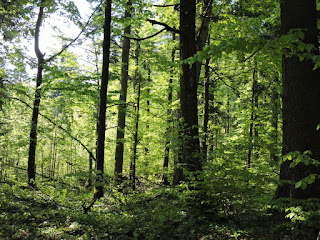 |
| Rock Thrush Monticola saxatilis (male), Mt. Nanos, 3rd May 2016. |
 |
| Rock Thrush's breeding habitat on Mt. Nanos, 3rd May 2016. |
 |
| Gentiana verna ssp. tergestina, Mt. Nanos, 3rd May 2016. |
 |
| Amelanchier ovalis, Mt. Nanos, 3rd May 2016. |
 |
| Erysimum sylvestre, Mt. Nanos, 3rd May 2016. |
 |
| Sempervivum tectorum, Mt. Nanos, 3rd May 2016. |
 |
| Onosma javorkae (O. echioides), Mt. Nanos, 3rd May 2016. |
 |
| Geranium sanguineum, Mt. Nanos, 3rd May 2016. |
 |
| Iris illyrica, Mt. Nanos, 3rd May 2016. |
 |
| Nanos' rocky edge and south-west facing slopes, 3rd May 2016. |
 |
| View from the edge to the Vipava valley and Karst, 3rd May 2016. |
 |
| Short-toed Lark Calandrella brachydactyla, Vipava valley, 3rd May 2016. |
 |
| Lesser Grey Shrike Lanius minor, Vipava valley, 3rd May 2016. |
 |
| Cows in the Vipava valley (Trnovski gozd in the back), 3rd May 2016. |
On Tuesday 3rd May I visited the grassy meadows on the Nanos plateau and the nearby Vipava valley (Vipavska dolina) in western Slovenia. The weather was changeable (as it happens in spring) and unfortunately the overcast sky didn't allow me to take good pictures. The rocky grasslands on Nanos (at about 880 m a.s.l.) are coming back to life after the winter sleep, although the flowering season is quite late compared to the valley. Still a lot of the "early flowers" up there. The most interesting sighting was a male
Blue Rock Thrush Monticola solitarius holding territory on the same rocky ridge as a pair of
Rock Thrushes Monticola saxatilis. I've never seen the two species together in the same place, although I know it happens in some areas in Slovenia. Blue Rock Thrush usually inhabits the lower (and warmer) cliffs on a mountain, whereas Rock Thrush loves higher-laying rocky ridges and mountain pastures. Nanos is a known breeding area for Rock Thrushes, where I usually find them every spring - see
here and
here (for better pics!).
Instead of the local pair of Golden Eagles
Aquila chrysaetos, I observed two
Short-toed Eagles Circaetus gallicus, flying together near Nanos's edge and "hanging" in the wind. Year's first
Honey Buzzard Pernis apivorus on migration and a
Hobby Falco subbuteo performing an insect-hunt were also very welcome sights. Locally breeding birds included a singing Lesser Whitethroat
Sylvia curruca, Stonechat
Saxicola torquatus, Rock Bunting
Emberiza cia, Tree Pipit
Anthus trivialis, Woodlark
Lullula arborea & Skylark
Alauda arvensis, plus Cuckoo
Cuculus canorus and Golden Oriole
Oriolus oriolus in the forest.
Later on the same day I visited some areas in the Vipava valley where I observed a pair of
Short-toed Larks Calandrella brachydactyla on their breeding grounds. Although breeding has not been confirmed yet, one or two singing birds in two consecutive years indicate that. In the area there were also singing Crested Larks
Galerida cristata and Skylarks
Alauda arvensis and song comparison of the 3 larks was easy (I've actually never heard a Short-toed's song before). The territorial birds in the Vipava valley represent the only known (probable) breeding of Short-toed Lark in Slovenia in recent times (breeding reported in the 19th century).
Another species of national importance, living in the Vipava valley, is the
Lesser Grey Shrike Lanius minor. The bird's stronghold in Slovenia (just a few pairs actually) is restricted to a small area of poplar trees in Vipava's rural countryside. I check the site every season and once again I was glad to see the birds returning - observed a nice male, delivering the parrot-like song from trees and posts.
Nearby, perched on a wire, was also a beautiful male
Red-footed Falcon Falco vespertinus (I've seen a few on migration in the past days) and additional atmosphere was provided by singing Corn Buntings
Miliaria calandra and Wrynecks
Jynx torquilla.


































